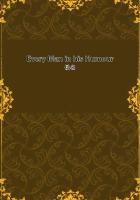If the reader has paid any attention to the story of the Anthrax, he must have perceived that my narrative is incomplete. The fox in the fable saw how the lion's visitors entered his den, but did not see how they went out. With us, it is the converse: we know the way out of the mason bee's fortress, but we do not know the way in.
To leave the cell of which he has eaten the owner, the Anthrax becomes a perforating machine, a living tool from which our own industry might take a hint if it required new drills for boring rocks. When the exit tunnel is opened, this tool splits like a pod bursting in the sun; and from the stout framework there escapes a dainty fly, a velvety flake, a soft fluff that astounds us by its contrast with the roughness of the depths whence it ascends. On this point, we know pretty well what there is to know. There remains the entrance into the cell, a puzzle that has kept me on the alert for a quarter of a century.
To begin with, it is evident that the mother cannot lodge her egg in the cell of the mason bee, which has been long closed and barricaded with a cement wall by the time that the Anthrax makes her appearance. To penetrate it, she would have to become an excavating tool once more and resume the cast-off rags which she left behind in the exit window; she would have to retrace her steps, to be reborn a pupa; and life knows none of these retrogressions. The full grown insect, if endowed with claws, mandibles and plenty of perseverance, might at a pinch force the mortar casket; but the fly is not so endowed. Her slender legs would be strained and deformed by merely sweeping away a little dust; her mouth is a sucker for gathering the sugary exudations of the flowers and not the solid pincers needed for the crumbling of cement. There is no auger either, no bore copied from that of the Leucospis, no implement of any kind that can work its way into the thickness of the wall and dispatch the egg to its destination. In short, the mother is absolutely incapable of settling her eggs in the chamber of the Mason bee.
Can it be the grub that makes its own way into the storeroom, that same grub which we have seen draining the Chalicodoma with its leech-like kisses? Let us call the creature to mind: a little oily sausage, which stretches and curls up just where it lies, without being able to shift its position. Its body is a smooth cylinder;its mouth simply a circular lip. Not one ambulatory organ does it possess; not even hairs, protuberances or wrinkles to enable it to crawl. The animal is made for digestion and immobility. Its organization is incompatible with movement; everything tells us so in the clearest fashion. No, this grub is even less able than the mother to make its way unaided into the mason's dwelling. And yet the provisions are there; those provisions must be reached: it is a matter of life or death; to be or not to be. Then how does the fly set about it? It would be vain for me to question probabilities, too often illusory; to obtain a reply of any value, I have but one resource; I must attempt the nearly impossible and watch the Anthrax from the egg onwards.
Although Anthrax flies are fairly common, in the sense of there being several different species, they are not plentiful when it is a case of wanting a colony populous enough to admit of continuous observation. I see them, now here, now there, in the fiercely sun-scorched places, flitting hither and thither on the old walls, the slopes and the sand, sometimes in small platoons, most often singly. I can expect nothing of those vagabonds, who are here today and gone tomorrow, for I know nothing of their settlements.
To keep a watch on them, one by one, in the blazing heat, is very painful and very unfruitful, as the swift-winged insect has a habit of disappearing one knows not whither just when a prospect of capturing its secret begins to offer. I have wasted many a patient hour at this pursuit, without the least result.
There might be some chance of success with Anthrax flies whose home was known to us beforehand, especially if insects of the same species formed a pretty numerous colony. The inquiries begun with one would be continued with a second and with more, until a complete verdict was forthcoming. Now, in the course of my long entomological career, I have met with but two species of Anthrax that fulfilled this condition and were to be found regularly: one at Carpentras; the other at Serignan. The first, Anthrax sinuata, FALLEN, lives in the cocoons of Osmia tricornis, who herself builds her nest in the old galleries of the hairy-footed Anthophora; the second, Anthrax trifasciata, MEIGEN, exploits the Chalicodoma of the Sheds. I will consult both.
Once more, here am I, somewhat late in life, at Carpentras, whose rude Gallic name sets the fool smiling and the scholar thinking.
Dear little town where I spent my twentieth year and left the first bits of my fleece upon life's bushes, my visit of today is a pilgrimage; I have come to lay my eyes once more upon the place which saw the birth of the liveliest impressions of my early days.
I bow, in passing, to the old college where I tried my prentice hand as a teacher. Its appearance is unchanged; it still looks like a penitentiary. Those were the views of our mediaeval educational system. To the gaiety and activity of boyhood, which were considered unwholesome, it applied the remedy of narrowness, melancholy and gloom. Its houses of instruction were, above all, houses of correction. The freshness of Virgil was interpreted in the stifling atmosphere of a prison. I catch a glimpse of a yard between four high walls, a sort of bear pit, where the scholars fought for room for their games under the spreading branches of a plane tree. All around were cells that looked like horse boxes, without light or air; those were the classrooms. I speak in the past tense, for doubtless the present day has seen the last of this academic destitution.















